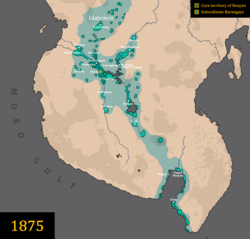
Back Sultanat von Buayan German Султанат Буајан Macedonian Sultanatet Buayan NB Sultanato ng Buayan Tagalog
Sultanate of Buayan كسولتانن نو بواين Kasultanan nu Buayan | |||||||||||
|---|---|---|---|---|---|---|---|---|---|---|---|
| c.1350–1905 | |||||||||||
 The territorial map of the Sultanate of Buayan in 1875 during the reign of Datu Uto. | |||||||||||
| Capital | Buayan (1350–c.1860) Bacat (c.1860–1872; 1875–1899) Kudarangan (1872–1875) Tinungkup (1899–1905) | ||||||||||
| Common languages | Maguindanaon, Iranun, Teduray, Manobo languages and Blaan | ||||||||||
| Religion | Islam | ||||||||||
| Demonym(s) | Buayanen | ||||||||||
| Government | Absolute monarchy | ||||||||||
| Sultan/Datu/Rajah | |||||||||||
• c.1350–1390 | Mamu | ||||||||||
• c.1390–1400s | Budtul | ||||||||||
• c.1400s–1500s | Malang-sa-Inged | ||||||||||
• 1596–1627 | Raja Silongan | ||||||||||
• 1875–1899 | Uto | ||||||||||
• 1899–1905 | Ali | ||||||||||
| History | |||||||||||
• Established by Datu Mamu | c.1350 | ||||||||||
• Arrival of Rajah Baguinda Ali | c.1390 | ||||||||||
• Reign of Datu Uto | 1875–1899 | ||||||||||
• Rise of Datu Ali | 1899–1905 | ||||||||||
| 1905 | |||||||||||
| Currency | Barter | ||||||||||
| |||||||||||
| Today part of | Philippines | ||||||||||
| History of the Philippines |
|---|
 |
| Timeline |
|
|
The Sultanate of Buayan (Maguindanaon: Kasultanan nu Buayan, Jawi: كسولتانن نو بواين; Filipino: Sultanato ng Buayan) was a Muslim state on the island of Mindanao in the southern Philippines from the mid-14th to the 20th century. Buayan was one of the four major sultanates in Mindanao, other sultanates being the Sultanate of Sulu, the Sultanate of Maguindanao, and the Confederate States of Lanao. Being the primary power in the upper Cotabato valley, it had access to an abundance of fertile land as well as raw materials, transforming into an agricultural powerhouse in contrast to Maguindanao. In addition, despite its status as an interior sultanate, Buayan was able to conduct maritime trade and diplomacy either through the Pulangi River mouth, or its port in Sarangani. At its maximum extent, its territory stretched from modern-day Kabuntalan to Sarangani Bay.[1][2][3]
Buayan was also well known for its long rivalry with Maguindanao, often using its alliance with Spain to weaken its rival and usurp the throne in Cotabato, as well as to monopolize on the trade, influence, and tribute from its weaker subjects over mainland Mindanao.
Its rulers, often referred to as the "Rajah Buayan" indicates a pre-existing Indianized form of governance in the region, already headed by a Rajah.[2]
The Sultanate of Buayan ceased to exist as a sovereign entity following the death of Datu Ali, cousin of Datu Uto of Buayan, after being killed in the Battle of the Malala River on 22 October 1905 against American forces. The American colonial administration was able to assert its authority with the aid of Datu Piang, the assumed ruler of Cotabato.[4]
- ^ Williams, Mark (2011). Business and Peace: The Case of La Frutera Plantation in Datu Paglas, Maguindanao, Philippines. Universal-Publishers. ISBN 9781612337586.
- ^ a b Ileto, Reynaldo Clemeña (2007). Magindanao, 1860-1888: The Career of Datu Utto of Buayan. Anvil Publishing, Inc., 2007. ISBN 9789712715853.
- ^ "The Power of Sulu - A Brief History of the Throne of Sulu (Part 1 of 2)". The Kahimyang Project. 2012-01-03. Retrieved 2024-01-08.
- ^ "1st Battalion 22nd Infantry - The Datu Ali Expedition". 1-22infantry.org. Retrieved 2023-09-14.